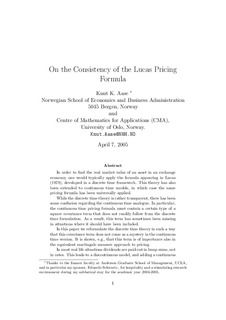| dc.description.abstract | In order to find the real market value of an asset in an exchange economy, one would typically apply the formula appearing in Lucas (1978), developed in a discrete time framework. This theory has also been extended to continuous time models, in which case the same pricing formula has been universally applied. While the discrete time theory is rather transparent, there has been some confusion regarding the continuous time analogue. In particular, the continuous time pricing formula must contain a certain type of a square covariance term that does not readily follow from the discrete time formulation. As a result, this term has sometimes been missing in situations where it should have been included. In this paper we reformulate the discrete time theory in such a way that this covariance term does not come as a mystery in the continuous time version. It is shown, e.g., that this term is of importance also in the equivalent martingale measure approach to pricing. In most real life situations dividends are paid out in lump sums, not in rates. This leads to a discontinuous model, and adding a continuous time framework, it appears that our framework is a most natural one in finance. | en |
